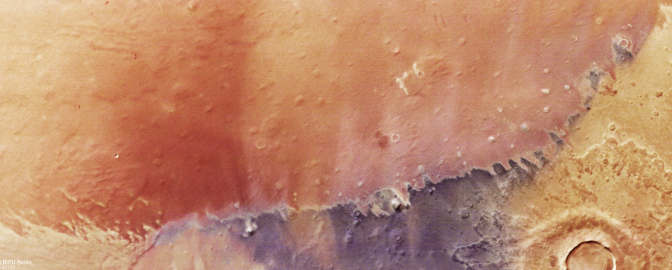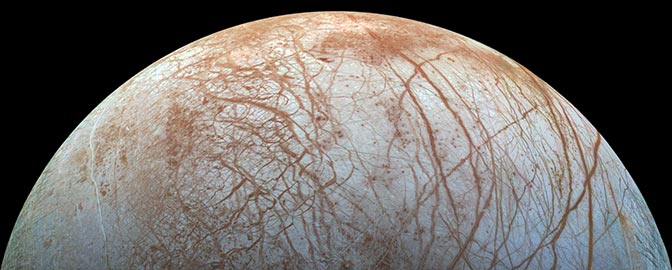The Downlink • Oct 03, 2025
Mars rock and roll
Space Snapshot

ESA’s ExoMars Trace Gas Orbiter captured this sequence of images of the Martian atmosphere, showing fine layers of cloud and dust throughout the atmosphere. Each vertical image (with Mars’ surface toward the bottom) shows a slice of the atmosphere 3.6 kilometers (2.2 miles) wide, backlit by sunlight at dusk. They were all captured on the same day, 200 kilometers (125 miles) apart. Changes in color represent different particle sizes, with smaller grains higher in the atmosphere. Learn more about ExoMars and what it is learning about Mars’ past and present habitability. Image credit: ESA/TGO/CaSSIS.
Fact Worth Sharing

Mars has the reverse of Earth’s daytime and sunset colors. Fine, iron-rich dust in the atmosphere tints the daylight sky reddish, but at sunset it scatters warm light and lets blue pass forward, creating a bluish glow around the Sun.
Space Advocate Update


NASA is closed. The U.S. federal government has shut down after Congress failed to agree on a budget for the 2026 fiscal year or provide a temporary extension of funding. 85% of NASA’s staff is now furloughed, though critical work will continue to support the ISS, space satellites, and Artemis II. The White House has threatened to impose mass firings during a shutdown, in addition to these temporary work stoppages, though how (or if) these would impact NASA is not clear. The Planetary Society is monitoring the situation closely and will share updates and actions you can take on our Save NASA Science Action Hub.

Save NASA Science Day of Action is next week. Registration closed this week for our upcoming Day of Action in Washington, D.C. This is now our most popular congressional visits event ever, with nearly 300 participants planning to attend. If you didn’t register, you can still take action with us on Monday, Oct. 6, by pledging to write or call your congressional offices.
Mission Briefings


Martian winds could help “tumbleweed rovers” get around. An international team of researchers has developed an experimental spacecraft that harnesses Mars’ strong winds for locomotion. The concept involves a swarm of spherical rovers being blown by Martian winds to enable large-scale and low-cost exploration. Team Tumbleweed presented the results of their initial field tests (pictured) at the recent Joint Meeting of the Europlanet Science Congress and the Division for Planetary Sciences. Image credit: Team Tumbleweed/Sas Schilten Testrun op de helling.

ISS spacesuits may not be safe for much longer. The spacesuits that International Space Station astronauts use for spacewalks were designed more than 50 years ago and have far exceeded their intended 15-year lifespan. A new report from the NASA Office of Inspector General suggests that their maintenance may also be inadequate, with critical spacesuit components not being replaced or repaired as needed.

ESA is aiming for Enceladus. The European Space Agency recently announced that it plans to send a spacecraft to Saturn's icy and potentially habitable moon Enceladus. The mission concept is part of ESA’s Voyage 2050, a long-term plan for space science activities.
From The Planetary Society


Perseverance’s find on Mars could be a game-changer. A sample collected on Mars (pictured) appears to contain unusual chemical and mineral patterns that may be potential signs of ancient life, but there’s a lot of research that still needs to be done to find out what it means. This week’s Planetary Radio features an interview with Joel Hurowitz, the lead author of the new Nature paper detailing the findings. You can also read an edited transcript of the conversation. Plus, learn more about the tools Perseverance used to make this discovery in an article by Planetary Society AAAS policy fellow Ari Koeppel. Image credit: NASA/JPL-Caltech.

It’s a big week for celebrating and appreciating space. Saturday, Oct. 4 is International Observe the Moon Night, a NASA-led event that encourages people around the world to look at the Moon, learn about lunar science, make lunar artwork, and more. Oct. 4 also kicks off World Space Week, with events around the world, fun educational resources for all ages, and opportunities to connect with other space enthusiasts.

New STEP Grants campaign match! Inspired by supporters like you, Ken Bowden, a generous Planetary Society member, has stepped up to add an additional $5,000 overall matching gift challenge for our STEP Grant program! Give today while every gift is worth DOUBLE, and you’ll do even more to empower the next group of innovative researchers and bolster independent scientific research!
What's Up

In the evening, look for reddish Mars very low in the west and yellowish Saturn shining in the east. The nearly full Moon will join Saturn on Oct. 5. Very bright Jupiter rises in the middle of the night in the east, and is high overhead before dawn. In the predawn, look for super bright Venus in the east.
Join now and save space missions

If you are not already a member, become one TODAY and help shape the future of space science and exploration by fueling mission-critical advocacy efforts. Our fight for space science is only possible because of the support of our members.
Will you join us and help save more missions?
Wow of the Week

This may be the most rock-n-roll stone on Mars. When NASA’s InSight lander touched down on the red planet in 2018, its thrusters propelled a golf ball-sized rock about 1 meter (3 feet), the farthest NASA has seen a rock roll due to a spacecraft landing. The InSight team named the rock “Rolling Stones Rock” to honor the famous band and this particular rock’s rolling journey. Image credit: NASA/JPL-Caltech.
Send us your artwork!
We love to feature space artwork in the Downlink. If you create any kind of space-related art, we invite you to send it to us by replying to any Downlink email or writing to [email protected]. Please let us know in your email if you’re a Planetary Society member!


 Explore Worlds
Explore Worlds Find Life
Find Life Defend Earth
Defend Earth

